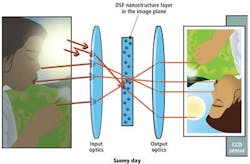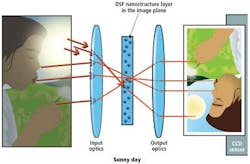IMAGE SENSORS: Smart filter increases dynamic range of cameras
In many machine-vision and image-processing systems, it is necessary to image scenes that contain very bright and very dark regions—especially in security systems that are often deployed outdoors and in applications such as welding, wherehigh-dynamic range images must be captured.
To increase the dynamic range of CCD and CMOS devices, many different sensor architectures and techniques can be used: dynamic well capacity adjustment, multiple image capture, spatially varying exposure times, time-to-saturation architectures, logarithmic transfer functions, and local intensity adaptation (see "Dynamic Design," Vision Systems Design, October 2009).
Using these architectures and techniques, camera manufacturers can offer high-dynamic range cameras that meet the needs of security and industrial applications where relatively fast frame rates are required.
However, increasing the dynamic range of camera systems need not be achieved just with digital techniques; such operations can also be performed optically.
At SPIE Defense, Security + Sensing Symposium held in Baltimore, Maryland in April 2012, KiloLambda (www.kilolambda.com) demonstrated its dynamic sunlight filter (DSF) that the company claims can increase the dynamic range of any CCD- or CMOS-based imager by up to 20 dB.
Although somewhat reticent to divulge the patented process behind the design, Ariela Donval, PhD and vice president of R&D with KiloLambda, likened the design of the filter to that used in photochromic lenses. In the design of such lenses, embedded microcrystalline silver halides in a glass substrate darken when exposed to ultraviolet rays found in sunlight. Because the photochromic lenses darken uniformly when exposed to sunlight, they are suitable for eyeglasses that eliminate the need for the consumer to carry a second pair of sunglasses.
While photochromic lenses act as filters, they simply attenuate the light passing through the glass. To increase the dynamic range of images passing through filters, it is necessary to limit the amount of intense light only in specific regions in which the amount of light is high.
To accomplish this, the KiloLambda DSF uses proprietary nonlinear nanostructures encapsulated between two layers of glass. When exposed to different light intensities, the DSF layer varies in transparency in accordance with the amount of incident light. Thus, bright sunlight within an image will be attenuated more than darker regions within the image (see figure). Therefore, the dynamic range of the image captured by the image sensor will be higher.
With a transition time of tens of milliseconds and a recovery time of seconds, the approach remains slower than that of digital techniques such as multiple exposure integration. However, because the DSF lens can be used with any camera system it may eventually be integrated directly into low-cost security systems.
KiloLambda has also demonstrated a variation of the DSF that can protect imaging equipment used in military systems such as binoculars, image-guided warheads, and cameras inunmanned aerial vehicles (UAVs). The so-called wideband laser protection filter (WPF) uses the same principle as the DSF except that should an imaging system be exposed to a high-powered laser, the filter irreversibly blocks the light in the image plane. Since only a small region of the resultant image will be blocked, the imager can continue to operate without saturation.

